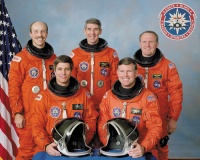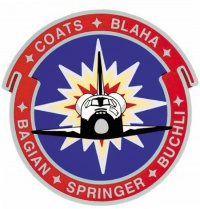STS-29
From The Space Library
 | |
| Organization | NASA-Office of Space Flight (United States) |
|---|---|
| Mission type | Human Crew |
| Launch date | March 13, 1989 |
| Launch vehicle | Space Shuttle |
| Launch site | Cape Canaveral, United States |
| COSPAR ID | 1989-021A |
| Inclination | 28.45 degrees |
| Experiments | Here |
| Alternate Names | 19882 |
| Additional Information | Here |
| Data Collection | Here |
| Payload Mass Up | 17280 kg |
| Payload Mass Down | 4482.27 kg |
| Orbiter | Discovery |
| Lift Off Mass | 2,056,482.27 kg |
| Orbiter Weight at Liftoff | 116,525.91 kg |
| Orbiter Weight at Landing | 88,540.45 kg |
| Landed | Concrete runway 22 at Edwards AFB, Calif. |
| Orbits of Earth | 79 |
| Orbital Altitude | 160 nautical miles (184 statute miles) |
Contents |
[edit] Crew
- Commander: Michael L. Coats
- Pilot: John E. Blaha
- Payload Commander:
- Mission Specialist 1: James F. Buchli
- Mission Specialist 2: Robert C. Springer
- Mission Specialist 3: James P. Bagian
[edit] Mission
The shuttle Discovery lifted off from the Kennedy Space Center pad 39B carrying a 5-man crew, a communications satellite and 6 onboard experiments. The 28th shuttle mission, the eighth for Discovery, was commanded by Michael L. Coats and piloted by John E. Blaha. Also onboard were mission specialists James F. Buchli, Robert C. Springer and James P. Bagian. Total liftoff weight was 2,049,888 kg, 119,269 kg of which was the orbiter and cargo. The Tracking and Data Relay Satellite (TDRS) was deployed 6 hrs, 13 mns after liftoff. With 2 TDRS's fully operational (F1 launched in April 1983; F3 in September 1988), STS 29/ground communications were uninterrupted over 85% of each orbit -- a fourfold improvement over pre-TDRS system shuttle flights. Following TDRS deployment (the mission's primary aim), the crew monitored experiments, assisted in calibration tests with the Air Force Maui Optical Site and filmed earth with an IMAX camera. One experiment, the Space Station Heat Pipe Advanced Radiator Element, a test of a new cooling system, failed when the cooling medium failed to move through the 15.7-m pipe. Discovery executed 5 somersaults on mission day 5 in an attempt to get the fluid moving, to no avail. The experiment is being redesigned for future flight tests. Discovery landed on Edwards AFB runway 22 at 14:36, March 18, after 4 days, 23 hrs, 39 mns in orbit.
[edit] Payload
Deploy IUS (Inertial Upper Stage) with Tracking and Data Relay Satellite (TDRS)-D; Protein Crystal Growth (PCG); Chromosome and Plant Cell Division in Space; IMAX 70mm camera; Shuttle Student Involvement Project (SSIP) experiments: SSIP 82-8, Effects of Weightlessness in Space Flight on the Healing of Bone Fractures, and SSIP 83-9, Chicken Embryo Development in Space; Air Force Maui Optical Site (AMOS) experiment
[edit] Books about the Space Shuttle Program
Buy This Book Click here |
Buy This Book here |
Buy This Book Click here |
Buy This Book Click here |





